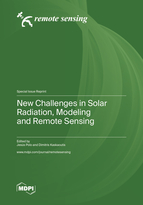New Challenges in Solar Radiation, Modeling and Remote Sensing
A special issue of Remote Sensing (ISSN 2072-4292). This special issue belongs to the section "Atmospheric Remote Sensing".
Deadline for manuscript submissions: closed (1 March 2023) | Viewed by 22087
Special Issue Editors
Interests: solar radiation; atmospheric physics; solar systems modeling; radiative transfer; remote sensing; solar power plant performance
Special Issues, Collections and Topics in MDPI journals
Interests: solar radiation; aerosols; remote sensing; dust; meteorology; climatology
Special Issues, Collections and Topics in MDPI journals
Special Issue Information
Dear Colleagues,
Surface solar radiation is of vital importance for life on Earth, radiation–energy balance, photosynthesis and photochemical reactions, meteorological and climatic conditions, and the water cycle. Solar radiation is the most abundant renewable energy resource and, therefore, the demands for environmentally clean energy solutions and a reduction in greenhouse gas emissions have shifted global interest toward exploitation of solar energy for sustainable development in meeting electricity demands. Solar radiation measurements are necessary in the assessment of potential solar energy resources, while their scarce spatial coverage renders solar radiation modeling and remote sensing necessary for atmospheric and energy applications. The recent applications in broadening the penetration of solar systems have given rise to new demands and challenges in modeling solar radiation and regarding the availability of new and better solar radiation products. Solar cadasters or modeling of solar radiation with complex topology (rear surface of bifacial PV systems), for instance, are just two specific examples of numerous topics. This Special Issue aims to review recent developments in obtaining solar radiation measurements of higher quality and modeling (solar radiation networks, historical developments, technique comparisons, and standard comparisons between models) and remote sensing using satellite and advanced statistical techniques such as artificial neural networks for solar radiation and energy mapping from regional to global scales. Satellite remote sensing of solar radiation provides better spatial coverage, and various methods have been developed for this, with the main disadvantages being the increased uncertainties and requirements for validation using ground-based measurements or modeling data.
Dr. Jesús Polo
Dr. Dimitris Kaskaoutis
Guest Editors
Manuscript Submission Information
Manuscripts should be submitted online at www.mdpi.com by registering and logging in to this website. Once you are registered, click here to go to the submission form. Manuscripts can be submitted until the deadline. All submissions that pass pre-check are peer-reviewed. Accepted papers will be published continuously in the journal (as soon as accepted) and will be listed together on the special issue website. Research articles, review articles as well as short communications are invited. For planned papers, a title and short abstract (about 100 words) can be sent to the Editorial Office for announcement on this website.
Submitted manuscripts should not have been published previously, nor be under consideration for publication elsewhere (except conference proceedings papers). All manuscripts are thoroughly refereed through a single-blind peer-review process. A guide for authors and other relevant information for submission of manuscripts is available on the Instructions for Authors page. Remote Sensing is an international peer-reviewed open access semimonthly journal published by MDPI.
Please visit the Instructions for Authors page before submitting a manuscript. The Article Processing Charge (APC) for publication in this open access journal is 2700 CHF (Swiss Francs). Submitted papers should be well formatted and use good English. Authors may use MDPI's English editing service prior to publication or during author revisions.
Keywords
- solar radiation
- models and techniques
- solar cadasters
- remote sensing
- modeling solar radiation with complex topology
- radiative forcing
- solar dimming/brightening
- PV systems
- solar radiation/energy mapping







